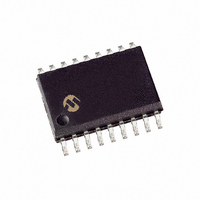PIC16F627-04/SO Microchip Technology, PIC16F627-04/SO Datasheet - Page 45

PIC16F627-04/SO
Manufacturer Part Number
PIC16F627-04/SO
Description
IC MCU FLASH 1KX14 COMP 18SOIC
Manufacturer
Microchip Technology
Series
PIC® 16Fr
Datasheet
1.PIC16F627-04P.pdf
(170 pages)
Specifications of PIC16F627-04/SO
Core Size
8-Bit
Program Memory Size
1.75KB (1K x 14)
Core Processor
PIC
Speed
4MHz
Connectivity
UART/USART
Peripherals
Brown-out Detect/Reset, POR, PWM, WDT
Number Of I /o
16
Program Memory Type
FLASH
Eeprom Size
128 x 8
Ram Size
224 x 8
Voltage - Supply (vcc/vdd)
3 V ~ 5.5 V
Oscillator Type
Internal
Operating Temperature
0°C ~ 70°C
Package / Case
18-SOIC (7.5mm Width)
Controller Family/series
PIC16F
No. Of I/o's
16
Eeprom Memory Size
128Byte
Ram Memory Size
224Byte
Cpu Speed
4MHz
No. Of Timers
3
Processor Series
PIC16F
Core
PIC
Data Bus Width
8 bit
Data Ram Size
224 B
Interface Type
SCI, USART
Maximum Clock Frequency
4 MHz
Number Of Programmable I/os
16
Number Of Timers
3
Operating Supply Voltage
3 V to 5.5 V
Maximum Operating Temperature
+ 70 C
Mounting Style
SMD/SMT
3rd Party Development Tools
52715-96, 52716-328, 52717-734
Development Tools By Supplier
PG164130, DV164035, DV244005, DV164005, PG164120, ICE2000, DM163014, DM164120-4
Minimum Operating Temperature
0 C
Lead Free Status / RoHS Status
Lead free / RoHS Compliant
For Use With
XLT18SO-1 - SOCKET TRANSITION 18SOIC 300MILAC164010 - MODULE SKT PROMATEII DIP/SOIC
Data Converters
-
Lead Free Status / Rohs Status
Details
Available stocks
Company
Part Number
Manufacturer
Quantity
Price
Company:
Part Number:
PIC16F627-04/SO
Manufacturer:
MIC
Quantity:
933
Part Number:
PIC16F627-04/SO
Manufacturer:
MICROCHI
Quantity:
20 000
6.0
The Timer0 module timer/counter has the following
features:
• 8-bit timer/counter
• Readable and writable
• 8-bit software programmable prescaler
• Internal or external clock select
• Interrupt on overflow from FFh to 00h
• Edge select for external clock
Figure 6-1 is a simplified block diagram of the Timer0
module. Additional information available in the
PICmicro™
Manual, DS31010A.
Timer mode is selected by clearing the T0CS bit
(OPTION<5>). In Timer mode, the TMR0 will increment
every instruction cycle (without prescaler). If Timer0 is
written, the increment is inhibited for the following two
cycles. The user can work around this by writing an
adjusted value to TMR0.
Counter mode is selected by setting the T0CS bit. In
this mode Timer0 will increment either on every rising
or falling edge of pin RA4/T0CKI. The incrementing
edge is determined by the source edge (T0SE) control
bit (OPTION<4>). Clearing the T0SE bit selects the
rising edge. Restrictions on the external clock input are
discussed in detail in Section 6.2.
The prescaler is shared between the Timer0 module
and the Watchdog Timer. The prescaler assignment is
controlled in software by the control bit PSA
(OPTION<3>). Clearing the PSA bit will assign the
prescaler to Timer0. The prescaler is not readable or
writable. When the prescaler is assigned to the Timer0
module, prescale value of 1:2, 1:4,..., 1:256 are
selectable. Section 6.3 details the operation of the
prescaler.
6.1
Timer0 interrupt is generated when the TMR0 register
timer/counter overflows from FFh to 00h. This overflow
sets the T0IF bit. The interrupt can be masked by
clearing the T0IE bit (INTCON<5>). The T0IF bit
(INTCON<2>) must be cleared in software by the
Timer0 module interrupt service routine before re-
enabling this interrupt. The Timer0 interrupt cannot
wake the processor from SLEEP since the timer is shut
off during SLEEP.
2003 Microchip Technology Inc.
TIMER0 MODULE
TIMER0 Interrupt
Mid-Range
MCU
Family
Reference
Preliminary
6.2
When an external clock input is used for Timer0, it must
meet certain requirements. The external clock
requirement is due to internal phase clock (T
synchronization. Also, there is a delay in the actual
incrementing of Timer0 after synchronization.
6.2.1
When no prescaler is used, the external clock input is
the same as the prescaler output. The synchronization
of
accomplished by sampling the prescaler output on the
Q2 and Q4 cycles of the internal phase clocks
(Figure 6-1). Therefore, it is necessary for T0CKI to be
high for at least 2T
and low for at least 2T
20 ns). Refer to the electrical specification of the
desired device.
When a prescaler is used, the external clock input is
divided by the asynchronous ripple-counter type
prescaler so that the prescaler output is symmetrical.
For the external clock to meet the sampling
requirement, the ripple-counter must be taken into
account. Therefore, it is necessary for T0CKI to have a
period of at least 4T
divided by the prescaler value. The only requirement
on T0CKI high and low time is that they do not violate
the minimum pulse width requirement of 10 ns. Refer to
parameters 40, 41 and 42 in the electrical specification
of the desired device. See Table 17-7.
T0CKI
Using Timer0 with External Clock
EXTERNAL CLOCK
SYNCHRONIZATION
with
OSC
OSC
the
(and a small RC delay of 20 ns)
OSC
(and a small RC delay of 40 ns)
internal
PIC16F62X
(and a small RC delay of
phase
DS40300C-page 43
clocks
OSC
is
)














